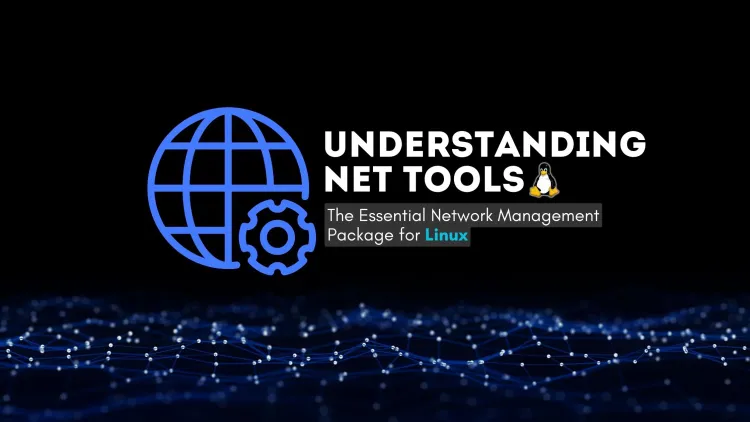Understanding Net-Tools | The Essential Network Management Package for Linux
Net-Tools is a comprehensive package of essential utilities for Linux networking, providing tools to manage network interfaces, ARP/RARP caches, routing tables, and more. It includes widely used commands like ifconfig, netstat, arp, and route, crucial for troubleshooting and advanced network management. While newer tools like ip from the iproute2 suite have emerged, Net-Tools remains popular for its simplicity and legacy compatibility. This blog explores the key utilities within the Net-Tools suite, their installation process, and how they help Linux administrators optimize and troubleshoot network configurations effectively.

Introduction to Net-Tools
The Net-Tools package is a crucial set of utilities for managing the network subsystem of the Linux kernel. It provides tools for configuring network interfaces, analyzing routing tables, manipulating ARP/RARP caches, and more. For network administrators and Linux enthusiasts, Net-Tools is indispensable for low-level control over networking functionalities.
What’s Included in Net-Tools?
Net-Tools comes with a variety of utilities for different networking tasks. Here’s an overview:
Key Tools in Net-Tools:
arp: Manipulates the system ARP cache.ifconfig: Configures network interfaces.netstat: Displays network connections, routing tables, and interface statistics.rarp: Manages the system RARP cache.nameif: Renames network interfaces based on MAC addresses.route: Displays and modifies the kernel routing table.
Specialized Utilities:
plipconfig: Configures PLIP devices.slattach: Attaches a network interface to a serial line.mii-tool: Handles media-independent interface status.iptunnel: Manages IP tunnels.ipmaddr: Configures multicast addresses.
How to Install Net-Tools
Installing Net-Tools on any Debian-based Linux distribution, including Kali Linux, is straightforward. Use the following command:
Detailed Overview of Tools
1. ARP (Address Resolution Protocol)
The arp tool is used to manage the ARP cache. It allows adding, deleting, or viewing ARP table entries.
2. Ifconfig
ifconfig configures and displays network interfaces. Though largely replaced by ip, it is still relevant in legacy systems.
3. Netstat
netstat provides detailed information about active connections, routing tables, and interface statistics.
4. IPMADDR
This utility manages multicast addresses for network interfaces.
5. IPTunnel
iptunnel creates and manages IP tunnels, often used in VPNs or custom routing setups.
6. MII-Tool
The mii-tool command allows interaction with media-independent interfaces.
7. Route
This tool manages the kernel routing table. It helps add, remove, or view routes.
8. Plipconfig
plipconfig adjusts parameters for PLIP devices (Parallel Line Internet Protocol).
9. Nameif
This tool renames network interfaces based on MAC addresses, ensuring consistent naming.
10. RARP
rarp manipulates the Reverse ARP table, useful in network boot scenarios.
11. SLAttach
This command attaches a network interface to a serial line.
Dependencies of Net-Tools
Net-Tools relies on several Linux kernel modules and libraries, including:
- ARP: Depends on the Linux ARP kernel module.
- RARP: Operates with RARP tables.
- Interface utilities: Require device-specific kernel drivers.
Conclusion
Despite the advent of newer tools like ip from the iproute2 suite, Net-Tools remains vital for Linux networking. Its wide array of utilities caters to basic and advanced networking needs, making it an indispensable package for Linux administrators.
By mastering these tools, you can:
- Troubleshoot complex network issues.
- Customize network configurations.
- Gain complete control over the Linux network stack.
Whether you're a seasoned administrator or a Linux enthusiast, Net-Tools is your gateway to proficient network management.
FAQ:
1. What is Net-Tools?
Net-Tools is a collection of networking utilities for Linux that helps configure and manage network settings. It includes tools like arp, ifconfig, netstat, and route, providing essential capabilities for network administration.
2. Why is Net-Tools important?
Net-Tools offers low-level control over network interfaces, ARP/RARP caches, routing tables, and more. These features make it indispensable for troubleshooting and managing Linux network environments.
3. How can I install Net-Tools on a Linux system?
You can install Net-Tools on Debian-based distributions using the following command:
4. Is Net-Tools still relevant with the introduction of iproute2?
Yes, while iproute2 provides newer tools like ip, Net-Tools is still widely used for its simplicity and compatibility with older systems.
5. What are some key utilities included in Net-Tools?
Net-Tools includes utilities like:
arp: Manages ARP cache.ifconfig: Configures network interfaces.netstat: Displays network statistics.route: Modifies routing tables.
6. How do I check active network connections using Net-Tools?
You can use the netstat command to view active connections:
7. What’s the difference between ifconfig and ip?
ifconfig is part of Net-Tools and manages network interfaces. The ip command from the iproute2 suite is a more modern and comprehensive replacement but is less intuitive for some users.
8. How do I add a default gateway using Net-Tools?
You can use the route command to add a default gateway:
9. Is Net-Tools available for all Linux distributions?
Most Linux distributions provide Net-Tools in their package repositories. However, it may not be pre-installed on newer distributions, requiring manual installation.
10. Can I use Net-Tools for advanced configurations like IP tunnels?
Yes, the iptunnel command in Net-Tools allows creating and managing IP tunnels for advanced networking needs like VPNs.
Example: iptunnel add mytunnel mode gre local 192.168.1.1 remote 192.168.2.1











![Top 10 Ethical Hackers in the World [2025]](https://www.webasha.com/blog/uploads/images/202408/image_100x75_66c2f983c207b.webp)



![[2025] Top 100+ VAPT Interview Questions and Answers](https://www.webasha.com/blog/uploads/images/image_100x75_6512b1e4b64f7.jpg)







